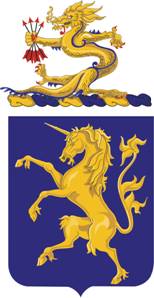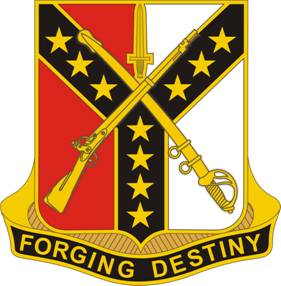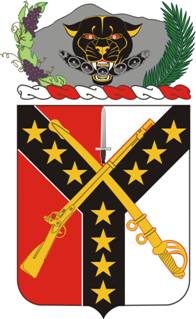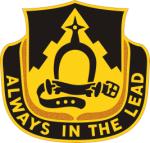
The 7th Cavalry Regiment is a United States Army cavalry regiment formed in 1866. Its official nickname is "Garryowen", after the Irish air "Garryowen" that was adopted as its march tune. The regiment participated in some of the largest battles of the Indian Wars, including its famous defeat at the Battle of Little Bighorn, where its commander Lieutenant Colonel George A. Custer was killed. The regiment also committed the Wounded Knee Massacre, where more than 250 men, women and children of the Lakota were killed.

The 11th Armored Cavalry Regiment is a unit of the United States Army garrisoned at the Fort Irwin National Training Center in California. Although termed an armored cavalry regiment, it is being re-organized as a multi-component heavy brigade combat team. The regiment has served in the Philippine–American War, the Pancho Villa Expedition, World War II, the Vietnam War, Gulf War and Iraq War. The 11th ACR serves as the opposing force (OPFOR) for the Army and Marine task forces, and foreign military forces that train at Fort Irwin.
The 12th Cavalry is a cavalry regiment of the United States Army.

The 8th Cavalry Regiment is a regiment of the United States Army formed in 1866 during the American Indian Wars. The 8th Cavalry continued to serve under a number of designations, fighting in every other major U.S. conflict since, except World War I, when it was not deployed to Europe because it was already engaged in the Punitive Expedition in Mexico from 1916 to 1920. It is currently a component of the 1st Cavalry Division.

The 6th Cavalry is a regiment of the United States Army that began as a regiment of cavalry in the American Civil War. It currently is organized into aviation squadrons that are assigned to several different combat aviation brigades.

The 1st Squadron, 75th Cavalry Regiment is a United States Army cavalry squadron established in 2004. It is the Reconnaissance, Surveillance and Target Acquisition Squadron (RSTA) squadron of the 2nd Brigade Combat Team "Strike" ♥, 101st Airborne Division. It performs reconnaissance and cavalry missions in support of that brigade.

The 1st Battalion, 68th Armor Regiment is a battalion of the 68th Armor Regiment, United States Army.

The 601st Tank Destroyer Battalion was a battalion of the United States Army active during World War II. It was the first of the newly formed tank destroyer battalions to see combat, and the only one to fight as a "pure" tank destroyer force. It also has the unusual distinction of being one of the few American units to fight in all three major campaigns against Nazi Germany and to have participated in four assault landings.
The 150th Cavalry Regiment is a regiment of the West Virginia Army National Guard, with troops in multiple locations throughout West Virginia and one troop in Sanford, North Carolina. It was originally formed as Greenbrier County militia, fighting for Virginia in the American Revolutionary War. During the American Civil War, companies of the regiment loyal to the recognized Union state government in Wheeling were later combined to form the Union Army's 5th and 9th West Virginia Infantry regiments, aiding in the defeat of Confederate troops in West Virginia, Ohio and Virginia.

The 252nd Armor Regiment is an armored regiment of the North Carolina Army National Guard, part of the 30th Armored Brigade Combat Team, which in turn is part of the 29th Infantry Division. The 252nd provides the majority of the 30th's heavy armor assets; the only other tank unit in "Old Hickory" is D Troop of the 150th Cavalry Regiment.

3rd Battalion, 153rd Infantry Regiment was a United States infantry battalion, headquartered at Warren, Arkansas, assigned to the 39th Infantry Brigade Combat Team of the Arkansas Army National Guard until it was deactivated on 5 September 2005. The history of the 3rd Battalion, 153rd Infantry as an individual battalion begins with the reorganization of the 39th Infantry Division in 1967 and the creation of the 39th Infantry Brigade (Separate). For history of the 3rd Battalion prior to 1967, see 153rd Infantry Regiment and 39th Infantry Division.

The 33rd Armor Regiment was an armored regiment in the United States Army first formed in 1941. In 2005, the 33rd Armor was redesignated 33rd Cavalry Regiment. The 1st Squadron, 33rd Cavalry Regiment, a part of the 3rd Brigade Combat Team, 101st Airborne Division, carries on the lineage of 33rd Armor Regiment.

The 71st Cavalry was originally constituted on 3 December 1941 in the Army of the United States as the 701st Tank Destroyer Battalion.

The 107th Cavalry Regiment, Ohio Army National Guard, is a parent regiment under the U.S. Army Regimental System, with headquarters at Hamilton, Ohio. It currently consists of the 2nd Squadron, 107th Cavalry Regiment, part of the 37th Infantry Brigade Combat Team (BUCKEYE), Ohio National Guard located throughout southwest Ohio.

The 1st Battalion, 107th Cavalry Regiment was a unit of the Ohio Army National Guard, with troops in multiple locations throughout northeastern Ohio and has served in the United States of America's major wars and conflicts since 1898 until its inactivation on 31 August 2007.

The 61st Cavalry Regiment is a regiment of the United States Army first established in 2004. The 1st, 2nd and 4th Squadrons are inactive. The 3rd Squadron is assigned to the 2nd Brigade Combat Team, 4th Infantry Division.

First Squadron, 153rd Cavalry Regiment "Darkhorse" is an element of the Florida Army National Guard, headquartered in Panama City, Florida with units throughout the Panhandle. It was formerly 3rd Battalion, 124th Infantry and officially converted to cavalry on 1 September 2007 when the 53rd Infantry Brigade converted from a "separate brigade" to the brigade combat team structure.

The 40th Armor Regiment was an armored regiment of the United States Army until the inactivation of its last element, its 1st Battalion, in 1996. It was redesignated and reactivated in 2005 as the 40th Cavalry Regiment and assigned to the 2nd Infantry Brigade Combat Team (Airborne), 11th Airborne Division.

The 303rd Cavalry Regiment is a United States cavalry regiment, currently represented in the Washington Army National Guard by the 1st Squadron, 303rd Cavalry, headquartered at Vancouver, Washington, part of the 96th Troop Command. It incorporates the lineage of the 303rd Cavalry, 303rd Armor, and 803rd Armor Regiments of the Washington Army National Guard.


















